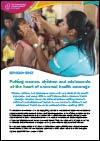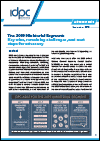What's New
Displaying results 1011 - 1020 of 4907

Resource | Publications,
Sixteen women living with HIV and 36 women with syphilis delivered during 2018. All pregnant women with HIV received treatment following national protocols, and the new-borns remain free of infection. Among pregnant women with syphilis, 97% received treatment and annual rate of congenital syphilis was 1.5 per 100 000 live births. Process indicators have improved with 97.5% in 2017 and 96.4% in 2018 for coverage of ANC attendance. These figures have been achieved through the government services. The screening coverage of pregnant women for HIV was 95.2% in 2017 and 95.9% in 2018 and for syphilis was 96.9% in 2017 and 99.3% in 2018.

Resource | Publications,
The Sustainable Development Goals and global political momentum behind Universal Health Coverage (UHC) offer significant opportunities to build collective global and national action towards achieving universal health coverage for adolescents. This paper sets out the evidence base on adolescent health and makes the case that to achieve Universal Health Coverage, policy makers need to take urgent action in the areas of service delivery, financing and governance.

Resource | Publications,
This Advocacy Brief from PMNCH on women, children and adolescents in universal health coverage (UHC) summarizes the key global evidence and arguments why the health needs of women, children and adolescents is central to the achievement of universal health coverage and the SDGs. It also demonstrates the return on investment for proven and cost-effective women, children and adolescent health interventions in terms of equity, human rights and economic productivity. This brief is intended for use as an advocacy resource, to encourage partners to unite around priority messages on UHC.

Resource | Publications,
2018 was an extraordinary year for PMNCH, with the diversity of our work showcased at the 2018 Partners’ Forum. Other achievements included our work in a number of EWEC focus areas, country engagement, accountability, political engagement and resource mobilization. The Board and Executive Committee also adopted the PMNCH 2018-2020 Business Plan.

Resource | Publications,
The Implementing Rules and Regulations (IRR) shall prescribe guidelines, procedures and standards for the implementation of the mandates and objectives of R.A. No. 11166, and to ensure and facilitate compliance to its provisions.

Resource | Publications,
S&D are globally recognized as key barriers to an effective HIV response. S&D by health care providers towards PLHIV, as well as populations at higher risk of HIV exposure, such as people who inject drugs (PWID), men who have sex with men (MSM), female sex workers (FSW) and Transgender persons (TG), can impact whether people feel comfortable accessing services for HIV related testing care and treatment.

Resource | Publications,
The report describes the findings from S&D surveys on health care provider and PLHIV and HIV integrated biological and behavioral surveillance (IBBS) among female and male sex workers, men who have sex with men and transgender women. Also described within this report are the methodologies used to collect data
from 19 provinces and the extrapolation process of provincial level data to provide national estimates. Of additional importance is that the process of data collection and extrapolation involved national capacity building to ensure technical expertise exists at the country level for follow up S&D surveys of PLHIV, KP, and health care providers.

Resource | Publications,
Held only three years after the 2016 United Nations General Assembly Special Session (UNGASS) on drugs, the event was a critical moment for member states to define the next decade of UN drug policy. It was clear early on in this process that member states did not want to embark in lengthy negotiations for a new substantive policy document, and as a result most of the negotiations revolved around whether to focus the next 10 years of drug control on UNGASS implementation, or on a reaffirmation of the 2009 Political Declaration, or a mix of both. At the core of these discussions was a fundamental disagreement over whether or not to extend the 2009 goals to ‘significantly reduce or eliminate’ the illicit drug market, given the clear lack of progress towards achieving any reduction in the global drug trade.

Resource | Publications,
The United Nations Development Programme’s (UNDP’s) Strategic Plan 2018–2021 and its HIV, Health and Development Strategy 2016–2021 highlight the role UNDP can play in supporting governments to attain the SDGs. This includes addressing the structural barriers and discriminatory laws, policies and practices that marginalize vulnerable population groups, including people who use drugs. In June 2015, UNDP released a discussion paper reviewing the impacts of drug enforcement policies on public health, safety and security, and human rights of poor and marginalized populations.






